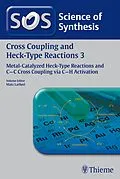In "Science of Synthesis: Cross Coupling and Heck-Type Reactions", expert authors present and discuss the best and most reliable methods currently available for the formation of new carbon-carbon and carbon-heteroatom bonds using these reactions, highlighted with experimental procedures. The three volumes provide an extensive overview of the current state of the art in this field of central importance in modern chemistry, and are an invaluable resource for synthetic organic chemists. This volume covers the different classes of Heck-type reactions. It describes the developments in each area whilst critically evaluating the strengths and weaknesses of the different methods. Many of these newly developed Heck-type methods feature operationally convenient conditions, high catalytic efficiency, and high levels of chemical, regiochemical, and stereochemical control. // The content of this e-book was originally published in Dec. 2012.
Zusammenfassung
In Science of Synthesis: Cross Coupling and Heck-Type Reactions, expert authors present and discuss the best and most reliable methods currently available for the formation of new carbon-carbon and carbon-heteroatom bonds using these reactions, highlighted with representative experimental procedures. Together, the three volumes of Cross Coupling and Heck-Type Reactions provide an extensive overview of the current state of the art in this field of central importance in modern chemistry, and are an invaluable resource for the practicing synthetic organic chemist.
This volume provides comprehensive coverage of the different classes of Heck-type reactions. It describes the state-of-the-art developments in each area whilst critically evaluating the strengths and weaknesses of the different methods. In accordance with the growing demand for synthetic efficiency and practicality in organic synthesis, many of these newly developed Heck-type methods feature operationally convenient conditions, high catalytic efficiency, and high levels of chemical, regiochemical, and stereochemical control. Metal-catalyzed C-H functionalization has also been developed into a powerful tool for organic synthesis, providing for original C-C disconnections in retrosynthetic analysis and improving the overall efficiency of the desired transformations. This volume also summarizes the most important concepts and methods in this hot research area.
This volume is part of a 3-volume set:
Cross Coupling and Heck-Type Reactions Workbench Edition
General information about Science of Synthesis
Inhalt
3.1 Heck Reactions
3.1.1 Intermolecular Reactions
3.1.1.1 Electron-Poor Alkenes as Reaction Components
3.1.1.1.1 Reaction with Aryl or Hetaryl Halides or Pseudohalides
3.1.1.1.2 Reaction with (Het)Arylmetals or (Het)Arenes
3.1.1.1.3 Reaction with Arene- or Hetarenecarboxylic Acids or Derivatives, or Related Compounds
3.1.1.1.4 Reaction with Nonaromatic Halides, Sulfonates, or Related Compounds
3.1.1.2 Alkenes with Allylic Substitution and Homologues as Reaction Components
3.1.1.3 Electron-Rich Alkenes as Reaction Components
3.1.1.3.1 Reaction with Aryl or Hetaryl Halides or Pseudohalides
3.1.1.3.2 Reaction with Arylboronic Acids or Derivatives or Aroyl Halides
3.1.1.3.3 Reaction with Nonaromatic Alkenyl Halides or Alkenyl Sulfonates
3.1.1.4 Cyclic Alkenes as Reaction Components
3.1.1.5 Alkenes with Metal-Directing Groups as Reaction Components
3.1.2 Intramolecular Reactions
3.1.2.1 Formation of Carbocycles
3.1.2.2 Formation of Heterocycles
3.1.2.3 Stereoselective Formation of Tertiary and Quaternary Centers
3.2 C-C Cross Coupling via Single C-H Activation
3.2.1 Intermolecular Coupling via C(sp2)-H Activation
3.2.2 Intramolecular Coupling via C(sp2)-H Activation
3.2.3 Coupling via C(sp3)-H Activation under Palladium Catalysis
3.3 C-C Cross Coupling via Double C-H Activation
